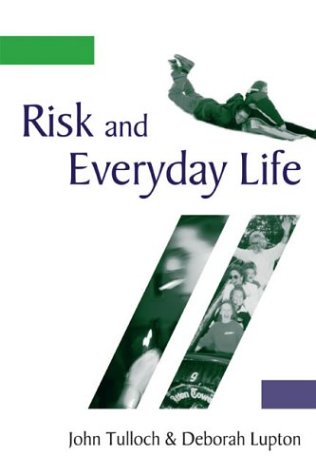Risk and Everyday Life
Tulloch, John and Deborah Lupton
Sage Publications, London
2003
0761947590 (pb)
 John Tulloch and Deborah Lupton, well known for their work around risk, use empirical research and sociocultural theory to consider risk in everyday life. The Introduction sets out the question that permeates the rest of the book, In this climate of heightened awareness and publicity about risk, how do people respond to, experience and think about risks as part of their everyday lives? As such, the book is likely to be relevant to many, whether familiar with sociocultural theory or not.
John Tulloch and Deborah Lupton, well known for their work around risk, use empirical research and sociocultural theory to consider risk in everyday life. The Introduction sets out the question that permeates the rest of the book, In this climate of heightened awareness and publicity about risk, how do people respond to, experience and think about risks as part of their everyday lives? As such, the book is likely to be relevant to many, whether familiar with sociocultural theory or not.
The first chapter really sets up the theoretical basis for the research undertaken and the core discussion throughout the book. In this chapter Tulloch and Lupton critique primarily the work of Ulrich Beck. Although only 15 pages in length, this is the densest chapter and takes some thought for those not immediately familiar with theory in this area. The authors cover many issues, such as Beck's broadly macro-sociological approach, which emphasizes the nature of risk at a political and structural level. This and other ideas are revisited and questioned later in the book when looking at the empirical evidence. The only slight irritation with the introduction is that each paragraph seems to start with 'According to Beck', 'Beck argues' or 'For Beck'. This leaves you knowing that the authors don't necessarily agree with all of Beck's arguments but you wish their viewpoint would be brought in sooner. When the authors do bring in their own viewpoint more they make the powerful argument that little research has enquired into the ways people broadly conceptualise risk and define 'risk' as a concept or understand why individuals may be willing to deliberately take risks (page 10). At the end of the critique the authors outline their own study aimed at addressing this gap in the literature and on which the rest of the book is based. A total of 134 interviews were carried out among a group of Britons and Australians. A good description of the study process and outline for remaining chapters is given. The rich interview data is then presented in the following chapters.
Chapter two provides an overview of the findings across the British and Australian interviews where as the Chapters three to six take the form of detailed case studies, looking in more depth at the specific discourses emerging from the data. These chapters are all highly readable and engaging. The authors are very good at relating specific themes back to the theory covered in chapter one and other chapters. For example, after presenting case studies from Australia and Britain about how people define risk, the authors reflect that, in large, interviewees' responses were around personal risk and that there was little consideration of external risks. This was in contrast to Beck's emphasis on the influence of big industry, science and the government (page 38). Tulloch and Lupton probably best describe this regular return to theory when they refer to the book as being a 'dialogue' with the ideas of Ulrich Beck. Throughout the book the use of detailed case studies works very well as you feel you are getting to know a lot about the interviewees and helps to build up a broader picture. The 'risk biographies', as the authors call them, allow you to see not only what interviewees perceive as risk but how these perceptions are constructed and the affects of these on everyday life. The authors return often to the point that Beck's Risk Society thesis, while not without its strengths, is lacking from an understanding of risk as perceived by people and as considered in everyday life. The interviews show in fact that reflections on risk were strongly shaped by factors such as gender, age, occupation, nationality and sexual identity and hence challenge some of Beck's generalisations.
The book ends with a 'Final Thoughts' section. When I saw that this was only two pages long I was slightly disappointed. I thought given the material that was covered in the book that it would have to be much more extensive than this. However, the authors manage to summarise the main arguments well and end by making the case for more research. I thought this book may have been a bit outside my field but I would thoroughly recommend it to anyone with a curiosity about the role of risk in life. It is extremely thought provoking and has made me consider my own definition and reaction to risk, which must be an indication of an engaging and well-written book.
Emma Pitchforth
University of Leicester

